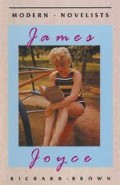Abstract
According to the witnesses assembled by Richard Ellmann, Joyce, having completed his book of a single day, moved on to tackle a book of the night. Most agree that the Wake, with the darkness and ambiguity of its language, its shifting and merging scenes and identities, and its deep structure of repeated family relationships can properly be called a ‘dream’. Critics such as Bekker (1982) and Norris (1974) show the relevance of the mechanisms of Freudian dream work. It may, as Edmund Wilson implied in his article ‘The Dream of H. C. Earwicker’, be possible to identify the dreamer, or even as subsequent critics such as Nathan Halper (in Dalton and Hart, 1966) and John Gordon (1986) have argued, to assign a place and date to the dream (19 March 1922 and 21 March 1938 respectively).
Preview
Unable to display preview. Download preview PDF.
Reading List
James A. Atherton, The Books at the Wake (New York: Viking, 1960).
Samuel Beckett et al., Our Exagmination Round his Factification for Incamination of Work in Progress (1929) (London: Faber, 1961).
Michael Begnal, Dreamscheme (Syracuse: Syracuse University Press, 1988).
Michael Begnal and Grace Eckley, Narrator and Character in Finnegans Wake (Lewisburg: Bucknell University Press, 1975).
Pieter Bekker, ‘Reading Finnegans Wake’, in James Joyce and Modern Literature, ed. W. J. McCormack and A. Stead (London: Routledge, 1982) pp. 185–201.
Bernard Benstock, Joyce-Again’s Wake (Seattle: University of Washington Press, 1965).
John Bishop, Joyce’s Book of the Dark (Madison: University of Wisconsin Press, 1986).
Joseph Campbell and Henry Morton Robinson, A Skeleton Key to Finnegans Wake (London: Faber, 1947).
Vincent Cheng, Shakespeare and Joyce: A Study of Finnegans Wake (Dublin: Colin Smythe, 1984).
Jack P. Dalton and Clive Hart (eds), Twelve and a Tilly (London: Faber, 1966).
Jacques Derrida, ‘Two Words for Joyce’, in Attridge and Ferrer (1984) pp. 145–159.
Adaline Glasheen, Third Census of Finnegans Wake (California: University of California Press, 1977).
John Gordon, Finnegans Wake: A Plot Summary (Dublin: Gill and Macmillan, 1986).
Clive Hart, Structure and Motif in Finnegans Wake (London: Faber, 1962).
David Hayman, A First-Draft Version of Finnegans Wake (London: Faber, 1963).
David Hayman, The ‘Wake’ in Transit (Ithaca: Cornell University Press, 1991).
Stephen Heath, ‘Ambiviolences’, in Attridge and Ferrer (1984) pp. 31–68.
F. R. Leavis, ‘James Joyce and “The Revolution of the Word”’, Scrutiny, vol. 2 (1933) no.1, pp. 193–201.
Roland McHugh, The Sigla of Finnegans Wake (London: Edward Arnold, 1976).
Roland McHugh, Annotations to Finnegans Wake (London: Routledge, 1980).
Louis Mink, A Finnegans Wake Gazetteer (Bloomington: Indiana University Press, 1978).
Margot Norris, The Decentered Universe of Finnegans Wake (Baltimore: Johns Hopkins University Press, 1974).
Margot Norris, ‘Finnegans Wake’, in Attridge (1990).
Denis Rose and John O’Hanlon, Understanding Finnegans Wake (New York: Garland, 1982).
Fritz Senn, ‘A Modest Proposal’, James Joyce Broadsheet, no. 7 (1982) p. 3.
James Snead, ‘Some Prefatory Remarks on Character in Joyce’, in Benstock (1988) pp. 139–147.
Brook Thomas, James Joyce’s “Ulysses”: A Book of Many Happy Returns (Baton Rouge: Louisiana State University Press, 1982).
William York Tindall, A Reader’s Guide to Finnegans Wake (London: Thames and Hudson, 1969)
Edmund Wilson, ‘The Dream of H. C. Earwicker’ in The Wound and the Bow (London: Methuen, 1961) pp. 218–43.
Copyright information
© 1992 Richard Brown
About this chapter
Cite this chapter
Brown, R. (1992). Finnegans Wake. In: James Joyce. Modern Novelists. Palgrave, London. https://doi.org/10.1007/978-1-349-21919-3_4
Download citation
DOI: https://doi.org/10.1007/978-1-349-21919-3_4
Publisher Name: Palgrave, London
Print ISBN: 978-0-333-41364-7
Online ISBN: 978-1-349-21919-3
eBook Packages: Palgrave Literature & Performing Arts CollectionLiterature, Cultural and Media Studies (R0)

